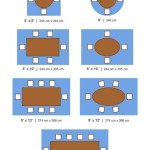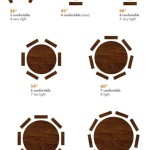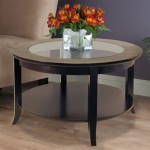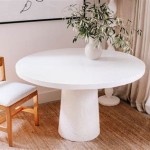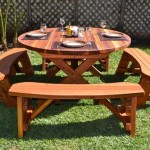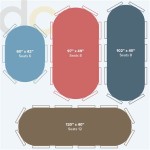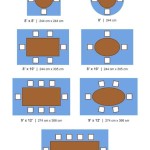Maximizing Your Space With A Round Dining Table
The round dining table is a furniture piece revered for its versatility and space-saving capabilities. Unlike its rectangular counterpart, it fosters a sense of intimacy and facilitates conversation, making it ideal for smaller dining areas and open-concept living spaces. Understanding the principles behind space optimization with a round table is key to achieving a functional and aesthetically pleasing dining environment.
The inherent design of a round table eliminates sharp corners, allowing for a more seamless flow within a room. This is particularly beneficial in smaller spaces where navigating around furniture can be challenging. The absence of corners also contributes to safety, reducing the risk of bumps and scrapes, especially for households with children. Furthermore, the circular shape promotes equal interaction among diners, encouraging a more inclusive and engaging dining experience.
The selection of a round dining table necessitates careful consideration of several factors, including the size of the room, the number of occupants, and the overall design aesthetic. A table that is too large can overwhelm a small space, while one that is too small may not adequately accommodate the needs of the household. Balancing these factors is crucial for achieving optimal functionality and visual harmony.
Understanding Space Requirements and Table Dimensions
Before purchasing a round dining table, it is essential to accurately assess the dimensions of the available space. Measure the area where the table will be placed, taking into account any obstructions such as doorways, windows, or furniture. Leave adequate space around the table for chairs to be pulled out comfortably and for people to move freely. A general guideline is to allow at least 36 inches between the edge of the table and any walls or obstacles. This ensures comfortable circulation and prevents the space from feeling cramped.
Round dining tables are typically categorized by their diameter. A smaller table, with a diameter of 36-48 inches, is suitable for seating two to four people. A medium-sized table, with a diameter of 48-60 inches, can comfortably accommodate four to six people. A larger table, with a diameter of 60 inches or more, is ideal for seating six to eight people or more. It is important to consider the number of people who will regularly use the table, as well as the maximum number of guests who may be seated for special occasions.
In addition to the table's diameter, consider the height of the table and the chairs. Standard dining table height is typically around 30 inches. Ensure that the chairs are the appropriate height to allow for comfortable dining. A good rule of thumb is to allow 12 inches between the seat of the chair and the tabletop. This provides ample legroom and prevents diners from feeling cramped or uncomfortable.
Extending round tables provide an option for flexible seating. These tables typically include leaves that can be added or removed to adjust the size of the table as needed. This is particularly beneficial for households that occasionally host larger gatherings but do not require a large table on a daily basis. When selecting an extending round table, ensure that the extension mechanism is sturdy and reliable, and that the table remains stable when fully extended.
Choosing the Right Materials and Style
The material and style of a round dining table can significantly impact the overall aesthetic of the dining area. Wood is a classic choice for dining tables, offering durability, warmth, and versatility. Different types of wood, such as oak, maple, and walnut, offer varying degrees of hardness, grain patterns, and coloration. Lighter woods, such as maple and birch, can create a brighter and more airy feel, while darker woods, such as walnut and mahogany, can add a touch of elegance and sophistication.
Glass-topped round dining tables are a popular choice for smaller spaces, as they create a sense of openness and transparency. The glass allows light to pass through, making the room feel larger and brighter. Glass tables are also easy to clean and maintain, making them a practical choice for busy households. However, they may require more frequent cleaning to remove fingerprints and smudges.
Metal-framed round dining tables offer a contemporary and industrial aesthetic. These tables are typically made from steel or aluminum and can be finished in a variety of colors, such as black, silver, or gold. Metal frames are durable and sturdy, providing a stable base for the tabletop. Metal tables are often paired with wooden or glass tabletops to create a visually interesting contrast.
The overall style of the round dining table should complement the existing décor of the dining area. If the room has a traditional aesthetic, a wooden table with ornate details may be appropriate. For a more modern space, a glass or metal table with clean lines may be a better choice. Consider the colors and textures of the surrounding furniture and accessories when selecting a table to ensure a cohesive and harmonious look.
Optimizing Space with Furniture Arrangement and Accessories
The arrangement of furniture around the round dining table can significantly impact the functionality and flow of the space. Avoid overcrowding the area with too much furniture. Only include essential pieces, such as chairs, a sideboard, or a buffet. Be mindful of the placement of these pieces to ensure that they do not obstruct pathways or make the room feel cramped.
Consider using chairs that can be easily tucked under the table when not in use. Armless chairs are often a better choice for smaller spaces, as they take up less room than chairs with arms. Stacking chairs are another option for maximizing space, as they can be stored away when not needed. When selecting chairs, ensure that they are comfortable and ergonomically designed to promote good posture.
Mirrors can be used to create the illusion of space in a small dining area. Place a large mirror on a wall opposite the dining table to reflect light and create a sense of depth. This can make the room feel larger and more open. Avoid placing mirrors in areas where they will reflect clutter or unsightly views.
Lighting plays a crucial role in creating a welcoming and inviting dining environment. Use a combination of ambient, task, and accent lighting to create a well-lit and layered effect. A chandelier or pendant light suspended above the dining table can serve as a focal point and provide ample illumination. Consider using dimmer switches to adjust the lighting levels to create different moods and atmospheres.
Accessories can be used to personalize the dining area and add visual interest. However, avoid cluttering the space with too many accessories. Choose a few key pieces that complement the style of the table and the room. A centerpiece on the dining table can add a touch of elegance and sophistication. Consider using fresh flowers, fruit, or candles to create a visually appealing display.
Rugs can help define the dining area and create a sense of warmth and comfort. Choose a rug that is large enough to accommodate all of the chairs when they are pulled out from the table. A rug that is too small can make the room feel disjointed. Consider the color and pattern of the rug when selecting one to ensure that it complements the overall décor of the dining area.
Wall art can add personality and visual interest to the dining area. Choose artwork that complements the style of the table and the room. Consider the size and scale of the artwork to ensure that it is proportionate to the wall space. Avoid hanging artwork too high or too low. A good rule of thumb is to hang artwork at eye level.
By carefully considering the size, material, style, and arrangement of a round dining table, individuals can effectively maximize space and create a functional and aesthetically pleasing dining environment. The key is to balance the practical needs of the household with the desired design aesthetic to achieve a harmonious and inviting space.

Space Saving Round Dining Table S Optimize Your Area Dphome

Round Dining Table S Storage And Space Saving Ideas For Each Home Dphome

Dining Table Sizes How To Choose The Right Size For Your Space

Dining Tables For Small Spaces Space Saving Ideas Ro Rj Living

Athmile Black Wood 47 In Round Pedestal Dining Table With Storage For 4 Blk 6504h120 A The Home Depot

Do Round Dining Tables Work In Rectangular Rooms Tips For Perfect Styling

Is It Good To Have A Round Or Square Dining Table

11 Extendable Taobao Furniture To Maximise Space

Is It Good To Have A Round Or Square Dining Table

Is It Good To Have A Round Or Square Dining Table
Related Posts

